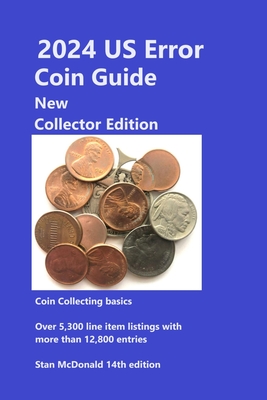You are here
Back to top2024 US Error Coin Guide - New Collector Edition (Paperback)
$16.97
Usually Ships in 1-5 Days
Description
The contents of this book have been written with 60 years of experience in numismatics, education and research, membership in coin clubs, and authoring articles for coin magazines. There are many books available for this subject, however, our guide is written by a lifelong collector with the accreditations to quality as a numismatist. This book is written for new collectors who want to learn about coin collecting and the fastest-growing area of collecting error coins. New collectors frequently make mistakes in identifying coin errors. It is important for all new collectors to familiarize themselves with the different error coin types. Coin Collecting Basics
Coin collecting basics such as coin details, coin abbreviations, coin specifications, mintmarks, mint locations, coin mintages, cleaning coins, counterfeits, and natural color are all musts for new collectors, and these are covered in this guide. In addition, coin preservation is important to ensure the surfaces of the coins remain in desirable condition. It is important to recognize coin variations, which can be categorized as intentional or non-intentional die changes. Common Minor Errors
Common error coins located in circulation include abrasions, BIE, minor broad strikes, bubbles, brass-colored Lincoln cents, uneven height, uncentered strikes, counter stamped, cracked, embedded bits of debris, die chips, die clashes, die deterioration, misalignment, blemishes, filled letters and numbers, flat and smooth lettering, hub errors, lamination, machine doubling, mint mark placement, missing letters and numbers, rotated mint marks, spilt rims, small rim dents, struck through, stripes, and oddities. All of these are carefully described in this guide. Error Coins versus Damaged Coins
New collectors need to be aware of damaged coins appearing like error coins. These issues include damaged rims, cuts and grooves, and discoloration not created by the US Mint. Die Creation
The US mint makes a minting die in specific steps. A hub is the inverse (incuse) of a die used to make coins. When the mint needs to create stamping dies, a metal rod is pressed into the hub, transferring the inverse image to the rod. The metal rod becomes the die used to make mint coins. The die continues in use until it needs refining or breaks. Minting Coins
The mint uses a blanking machine to stamp out planchets from the coil stock for all denominations except Lincoln cents. Lincoln cent blanks come from approved contractors, who send the blanks to the mint for stamping.
Three steps occur in the process: annealing, washing, and edging. Annealing the metal softens it for stamping. The blank planchets are type I. The next step is to place an edge on the blanks, creating planchets ready for minting. The blanks with upset edging are type II. Coins get bagged, boxed, and ready for shipment to the Federal Reserve Banks. The Federal Reserve Banks then distribute the coins to their customers.
The three major error categories-planchet, die, and striking errors-are described in detail with descriptions and photos. Obtaining the best equipment for error detection can help the collector find error coins still in circulation. The importance of coin-collecting organizations and detecting counterfeit coins. Doubled die and RPM error detection using the information in this guide will help a new collector become successful. Finding major and minor error coins and which error coins are not of added value.
Locating error coins is essential for increasing the odds of finding rare error coins. A machine-doubled coin versus an authentic error coin will help new collectors avoid making mistakes with identification.
